汇总小学英语全英教案模板
小学英语的全英文教案范文
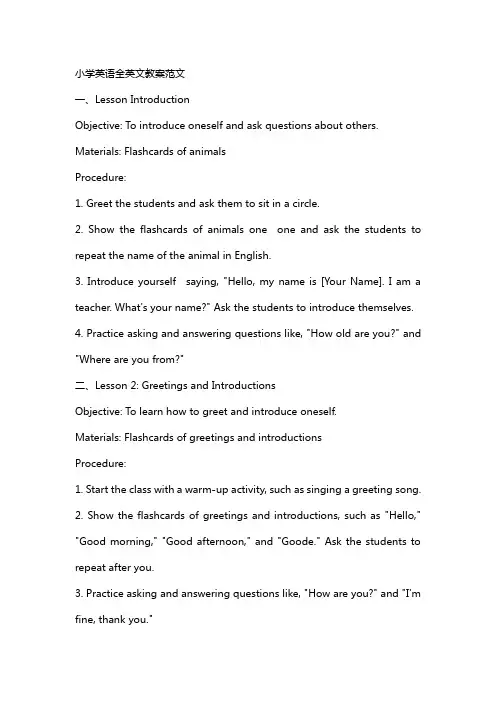
小学英语全英文教案范文一、Lesson IntroductionObjective: To introduce oneself and ask questions about others. Materials: Flashcards of animalsProcedure:1. Greet the students and ask them to sit in a circle.2. Show the flashcards of animals one one and ask the students to repeat the name of the animal in English.3. Introduce yourself saying, "Hello, my name is [Your Name]. I am a teacher. What's your name?" Ask the students to introduce themselves.4. Practice asking and answering questions like, "How old are you?" and "Where are you from?"二、Lesson 2: Greetings and IntroductionsObjective: To learn how to greet and introduce oneself.Materials: Flashcards of greetings and introductionsProcedure:1. Start the class with a warm-up activity, such as singing a greeting song.2. Show the flashcards of greetings and introductions, such as "Hello," "Good morning," "Good afternoon," and "Goode." Ask the students to repeat after you.3. Practice asking and answering questions like, "How are you?" and "I'm fine, thank you."4. Introduce a new student to the class and ask the students to greet and introduce themselves.三、Lesson 3: ColorsObjective: To learn how to name and describe colors in English. Materials: Flashcards of colorsProcedure:1. Start the class showing a colorful picture or object and ask the students to name the colors.2. Show the flashcards of colors one one and ask the students to repeat the color name in English.3. Practice describing colors using phrases like, "It's blue," "It's a red car," and "The sky is blue."4. Draw a colorful picture with the students and ask them to name the colors as you draw.四、Lesson 4: Numbers 1-10Objective: To learn how to count from 1 to 10 in English.Materials: Number flashcards, objects to countProcedure:1. Start the class counting with the students, "One, two, three, four, five." Continue counting up to 10.2. Show the number flashcards one one and ask the students to repeat the number in English.3. Give the students a set of objects, such as counters or toys, and ask them to count the objects using English numbers.4. Play a number game, such as "Simon Says" or "Number Memory," to reinforce the counting skills.五、Lesson 5: AlphabetObjective: To learn the English alphabet and the sounds of each letter. Materials: Alphabet flashcards, letter sounds chartProcedure:1. Start the class singing the "Alphabet Song" to familiarize the students with the English alphabet.2. Show the alphabet flashcards one one and ask the students to repeat the letter name in English.3. Expln the sounds of each letter in the alphabet using a letter sounds chart.4. Practice tracing the letters of the alphabet on a large whiteboard or chart paper, and ask the students to follow along.六、Lesson 6: Family MembersObjective: To learn how to name family members in English. Materials: Flashcards of family membersProcedure:1. Start the class asking the students about their family members in their native language.2. Introduce the concept of family members in English showing the flashcards of family members, such as "mother," "father," "brother," "sister," and "grandparent."3. Practice asking and answering questions about family members, like "Who is your mother?" and "I have a sister."4. Ask the students to bring a picture of their family and describe their family members in English.七、Lesson 7: Dly RoutinesObjective: To learn how to describe dly routines in English. Materials: Flashcards of dly routinesProcedure:1. Start the class discussing the dly routines of the students in their native language.2. Introduce the concept of dly routines in English showing the flashcards of dly routines, such as "wake up," "eat breakfast," "go to school," and "play."3. Practice asking and answering questions about dly routines, like "What do you do in the morning?" and "What do you do after school?"4. Ask the students to role-play their dly routines using English words and phrases.八、Lesson 8: ClothingObjective: To learn how to name and describe different types of clothingin English.Materials: Flashcards of clothingProcedure:1. Start the class discussing the types of clothing worn in different seasons.2. Introduce the concept of clothing in English showing the flashcards of different types of clothing, such as "shirt," "pants," "dress," "sunglasses," and "hat."3. Practice asking and answering questions about clothing, like "What are you wearing today?" and "I am wearing a skirt."4. Ask the students to bring a picture of themselves in different types of clothing and describe their clothing in English.九、Lesson 9: Food and DrinksObjective: To learn how to name and describe different foods and drinks in English.Materials: Flashcards of food and drinksProcedure:1. Start the class discussing the types of food and drinks liked the students.2. Introduce the concept of food and drinks in English showing the flashcards of different food and drink items, such as "apple," "banana," "orange," "milk," and "water."3. Practice asking and answering questions about food and drinks, like "What is your favorite fruit?" and "Can I have some water, please?"4. Ask the students to bring a picture of their favorite food or drink and describe it in English.十、Lesson 10: Review and AssessmentObjective: To review the topics covered in the previous lessons and assess the students' understanding.Materials: Review worksheets, flashcardsProcedure:1. Start the class reviewing the topics covered in the previous lessons, such as greetings, introductions, colors, numbers, family members, dly routines, clothing, food and drinks.2. Conduct a mini-assessment to evaluate the students' understanding asking them to answer questions related to the topics.3. Use flashcards to test the students' vocabulary retention asking them to name the items in English.4. Provide review worksheets for the students to plete, which include exercises like fill in the blanks, match the words with their pictures, and write short sentences using the learned vocabulary.5. Give feedback to the students on their performance and encourage them to continue practicing their English skills.重点和难点解析一、Lesson Introduction重点关注环节:Students' ability to ask and answer questions about themselves.难点解析:This lesson introduces the concept of asking and answering questions about oneself, which is a fundamental skill in language learning. The students may find it challenging to express their personal information accurately and confidently in English.二、Lesson 2: Greetings and Introductions重点关注环节:Students' ability to use greetings and introduce themselves.难点解析:Using proper greetings and introductions is crucial in dly munication. The students might struggle with remembering and applying the correct phrases in different situations.三、Lesson 3: Colors重点关注环节:Students' ability to name and describe colors in English. 难点解析:Naming and describing colors can be challenging for students, especially those whose native language does not use the same color palette as English.四、Lesson 4: Numbers 1-10重点关注环节:Students' ability to count from 1 to 10 in English.难点解析:Counting is a foundational math skill that can be difficult for students to master when learning a new language, as it involvesunderstanding the numerical system and sequencing.五、Lesson 5: Alphabet重点关注环节:Students' ability to recognize and pronounce each letter of the English alphabet.难点解析:The English alphabet may have letters that are not present in the students' native language, making it challenging for them to recognize and pronounce them correctly.六、Lesson 6: Family Members重点关注环节:Students' ability to name family members in English and ask about others'.难点解析:Understanding and using family vocabulary can be emotional and personal for students. They may find it difficult to remember the English words for extended family members or to ask about others' families.七、Lesson 7: Dly Routines重点关注环节:Students' ability to describe their dly routines in English. 难点解析:Describing routines involves sequencing and using past tense verbs, which can be plex for beginners to grasp.八、Lesson 8: Clothing重点关注环节:Students' ability to name and describe different types of clothing in English.难点解析:Clothing terms can be abstract and may not have directtranslations in students' native languages. Additionally, students may be self-conscious about discussing their attire.九、Lesson 9: Food and Drinks重点关注环节:Students' ability to name and describe different foods and drinks in English.难点解析:Food and drink vocabulary can be extensive, and students may have difficulty remembering the names of specific items or describing preferences.十、Lesson 10: Review and Assessment重点关注环节:Students' ability to review and apply the knowledge gned from the previous lessons.难点解析:Assessment can be stressful for students, especially if they feel unprepared. Ensuring that the review is prehensive and allows for individualized learning is crucial.这些教案环节涵盖了从自我介绍到日常生活中的各种主题,每个环节都有其特定的重点和难点。
小学英语教案全英文版
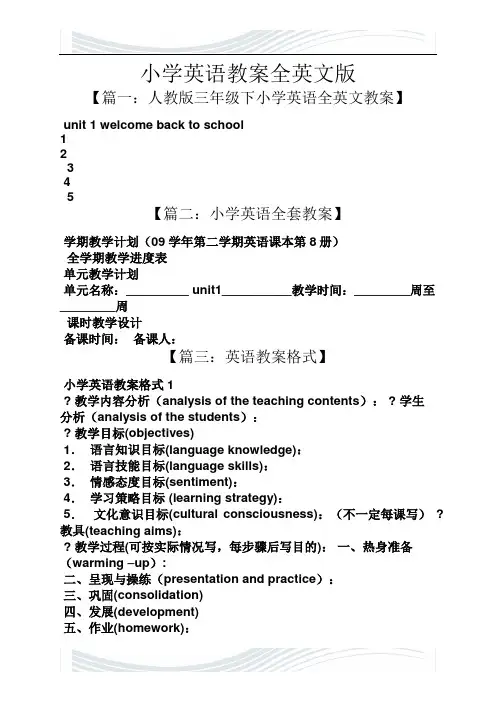
小学英语教案全英文版【篇一:人教版三年级下小学英语全英文教案】unit 1 welcome back to school12345【篇二:小学英语全套教案】学期教学计划(09学年第二学期英语课本第8册)全学期教学进度表单元教学计划单元名称:_________ unit1__________教学时间:________周至________周课时教学设计备课时间:备课人:【篇三:英语教案格式】小学英语教案格式1? 教学内容分析(analysis of the teaching contents): ? 学生分析(analysis of the students):? 教学目标(objectives)1.语言知识目标(language knowledge):2.语言技能目标(language skills):3.情感态度目标(sentiment):4.学习策略目标 (learning strategy):5.文化意识目标(cultural consciousness):(不一定每课写)? 教具(teaching aims):? 教学过程(可按实际情况写,每步骤后写目的):一、热身准备(warming –up):二、呈现与操练(presentation and practice):三、巩固(consolidation)四、发展(development)五、作业(homework):? 板书设计:? 附上练习:范例一:unit3 let’s talk 第一课时小学三年级教学重点:how are you? fine, thank you. 等问候语的学习。
教学难点: 1、how are you? 的得体运用。
2、fine, thank you.中 fine 一词字母 i 的发音不容易到位。
教具准备:1、本课let’s talk/a 部分的教学课件。
2、教师为学生准备3—4个扩音器。
3、本课时教学配套的录音带,以及歌曲“hello”“head, shoulders, knees and toes”的录音带。
全英版小学英语教案【三篇】
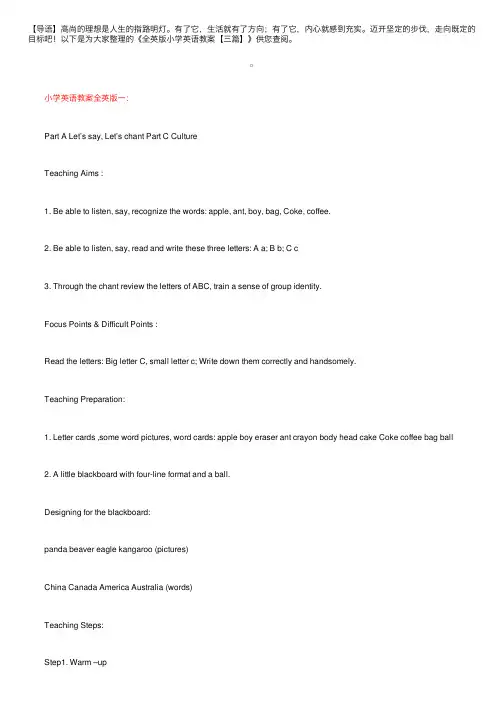
【导语】⾼尚的理想是⼈⽣的指路明灯。
有了它,⽣活就有了⽅向;有了它,内⼼就感到充实。
迈开坚定的步伐,⾛向既定的⽬标吧!以下是为⼤家整理的《全英版⼩学英语教案【三篇】》供您查阅。
⼩学英语教案全英版⼀: Part A Let’s say, Let’s chant Part C Culture Teaching Aims : 1. Be able to listen, say, recognize the words: apple, ant, boy, bag, Coke, coffee. 2. Be able to listen, say, read and write these three letters: A a; B b; C c 3. Through the chant review the letters of ABC, train a sense of group identity. Focus Points & Difficult Points : Read the letters: Big letter C, small letter c; Write down them correctly and handsomely. Teaching Preparation: 1. Letter cards ,some word pictures, word cards: apple boy eraser ant crayon body head cake Coke coffee bag ball 2. A little blackboard with four-line format and a ball. Designing for the blackboard: panda beaver eagle kangaroo (pictures) China Canada America Australia (words) Teaching Steps: Step1. Warm –up 1. Sing a song. 2. Free talk T: Hello. I’m Wendy. I’m from Hangzhou. S1: Hello! I’m ... I’m from Hangzhou,too. T: Nice to meet you. S: Nice to meet you, too. T: Let’s play. Ok? S: Great! T: Watch out! (T throws the ball.) S: Oh, no. Make a similar dialogue with your partner. Step2.Presentation. 1. 1)T : Today, we will learn letters. Do you know letters? Just as A,B,C…… They are letters. What’s the meaning of letters? S: 字母。
小学英语全英万能教案模板
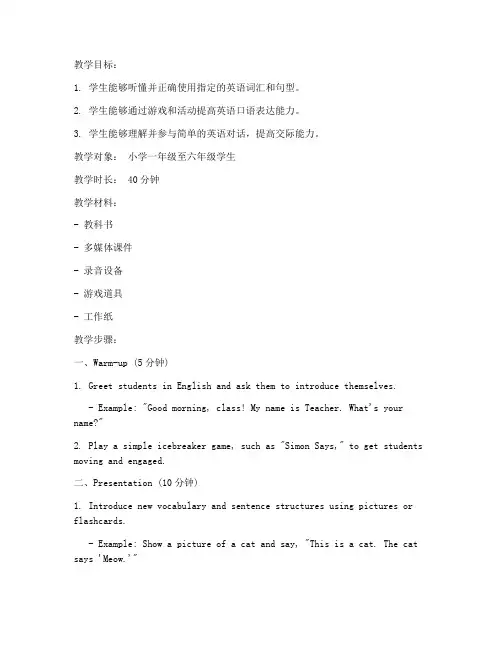
教学目标:1. 学生能够听懂并正确使用指定的英语词汇和句型。
2. 学生能够通过游戏和活动提高英语口语表达能力。
3. 学生能够理解并参与简单的英语对话,提高交际能力。
教学对象:小学一年级至六年级学生教学时长: 40分钟教学材料:- 教科书- 多媒体课件- 录音设备- 游戏道具- 工作纸教学步骤:一、Warm-up (5分钟)1. Greet students in English and ask them to introduce themselves.- Example: "Good morning, class! My name is Teacher. What's your name?"2. Play a simple icebreaker game, such as "Simon Says," to get students moving and engaged.二、Presentation (10分钟)1. Introduce new vocabulary and sentence structures using pictures or flashcards.- Example: Show a picture of a cat and say, "This is a cat. The cat says 'Meow.'"2. Use a PowerPoint or whiteboard to demonstrate the vocabulary and sentence structures.- Example: "Can you show me a book? Yes, I can show you a book. Can you give me a pen? Yes, I can give you a pen."三、Practice (15分钟)1. Pair students up and have them practice the new vocabulary and sentence structures in a dialogue format.- Example: "A: What's this? B: This is a ball. A: Can you throw the ball? B: Yes, I can throw the ball."2. Organize a role-play activity where students act out a short scenario using the new language.- Example: "A: I want to go to the park. B: OK, let's go to the park together."四、Game (10分钟)1. Play a fun and interactive game related to the new vocabulary and sentence structures.- Example: "Memory Game" where students find matching pictures or cards with the new vocabulary.五、Conclusion (5分钟)1. Review the new vocabulary and sentence structures with the class.- Example: "Today we learned about animals. Can you tell me what an animal says?"2. Have students create a short sentence using the new vocabulary.- Example: "I see a dog. The dog says 'Woof.'"六、Homework (5分钟)1. Assign a simple homework task to reinforce the lesson.- Example: "Draw a picture of your favorite animal and write a sentence about it."七、Assessment- Observe student participation and engagement during the activities.- Check homework submissions for understanding and application of the new language.备注:- 根据学生的年龄和英语水平,调整教学材料和活动难度。
小学全英英语教案万能模板
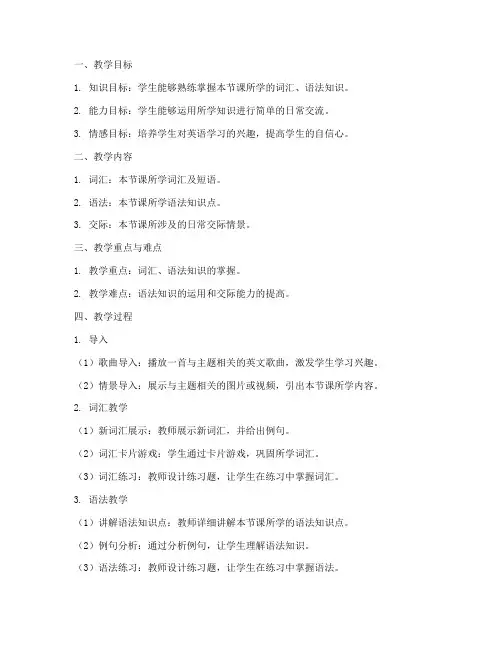
一、教学目标1. 知识目标:学生能够熟练掌握本节课所学的词汇、语法知识。
2. 能力目标:学生能够运用所学知识进行简单的日常交流。
3. 情感目标:培养学生对英语学习的兴趣,提高学生的自信心。
二、教学内容1. 词汇:本节课所学词汇及短语。
2. 语法:本节课所学语法知识点。
3. 交际:本节课所涉及的日常交际情景。
三、教学重点与难点1. 教学重点:词汇、语法知识的掌握。
2. 教学难点:语法知识的运用和交际能力的提高。
四、教学过程1. 导入(1)歌曲导入:播放一首与主题相关的英文歌曲,激发学生学习兴趣。
(2)情景导入:展示与主题相关的图片或视频,引出本节课所学内容。
2. 词汇教学(1)新词汇展示:教师展示新词汇,并给出例句。
(2)词汇卡片游戏:学生通过卡片游戏,巩固所学词汇。
(3)词汇练习:教师设计练习题,让学生在练习中掌握词汇。
3. 语法教学(1)讲解语法知识点:教师详细讲解本节课所学的语法知识点。
(2)例句分析:通过分析例句,让学生理解语法知识。
(3)语法练习:教师设计练习题,让学生在练习中掌握语法。
4. 交际教学(1)情景模拟:教师创设与主题相关的情景,让学生进行角色扮演。
(2)小组讨论:学生分组讨论,运用所学知识进行交流。
(3)课堂展示:各小组展示讨论成果,教师进行点评。
5. 总结与反馈(1)总结:教师对本节课所学内容进行总结,强调重点和难点。
(2)反馈:学生回答问题,教师进行点评和纠正。
五、课后作业1. 完成课后练习题,巩固所学知识。
2. 预习下一节课的内容。
六、教学反思1. 教学过程中,关注学生的参与度和学习效果。
2. 根据学生的实际情况,调整教学方法和进度。
3. 鼓励学生积极参与课堂活动,提高学生的交际能力。
注:以上模板仅供参考,教师可根据实际情况进行调整。
小学英语全英文教案小学英语说课模板汇总小学英语说课教案万能模板全英(三篇)
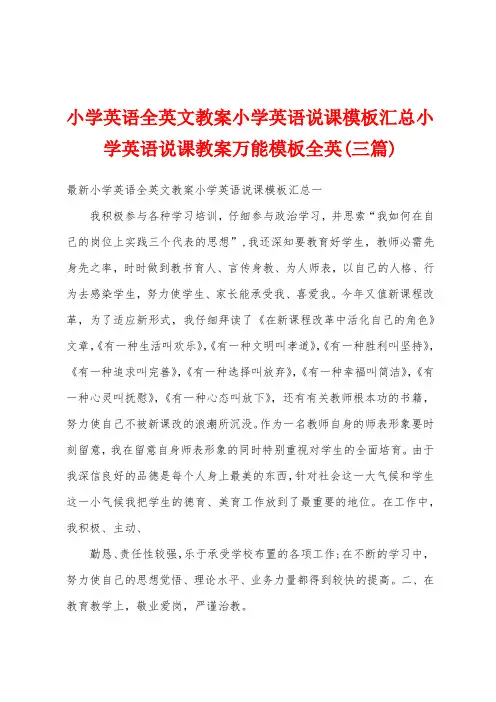
小学英语全英文教案小学英语说课模板汇总小学英语说课教案万能模板全英(三篇)最新小学英语全英文教案小学英语说课模板汇总一我积极参与各种学习培训,仔细参与政治学习,并思索“我如何在自己的岗位上实践三个代表的思想”,我还深知要教育好学生,教师必需先身先之率,时时做到教书育人、言传身教、为人师表,以自己的人格、行为去感染学生,努力使学生、家长能承受我、喜爱我。
今年又值新课程改革,为了适应新形式,我仔细拜读了《在新课程改革中活化自己的角色》文章,《有一种生活叫欢乐》,《有一种文明叫孝道》,《有一种胜利叫坚持》,《有一种追求叫完善》,《有一种选择叫放弃》,《有一种幸福叫简洁》,《有一种心灵叫抚慰》,《有一种心态叫放下》,还有有关教师根本功的书籍,努力使自己不被新课改的浪潮所沉没。
作为一名教师自身的师表形象要时刻留意,我在留意自身师表形象的同时特别重视对学生的全面培育。
由于我深信良好的品德是每个人身上最美的东西,针对社会这一大气候和学生这一小气候我把学生的德育、美育工作放到了最重要的地位。
在工作中,我积极、主动、勤恳、责任性较强,乐于承受学校布置的各项工作;在不断的学习中,努力使自己的思想觉悟、理论水平、业务力量都得到较快的提高。
二、在教育教学上,敬业爱岗,严谨治教。
“把学生看成是魔鬼,你就生活在地狱;把学生看成是天使,你就生活在天堂。
”把学生教好,让学生胜利,是每位教师最大的心愿、最高的荣誉。
作为一名小学英语教师,而且是城区教研中心教研组的组长,我深感责任重大,尽自己最大努力把自己的工作做的完善。
对于课程改革环境下的教师,光有一桶水是不够的,教师要拥有自来水。
在工作中,我深知学习的重要性,抓住一切时机仔细学习,在不断学习、不断实践中不断提高自己的教育教学水平及教学治理水平。
抓住学校安排外出听课的时机,虚心学习,不耻下问,准时消化,吸取别人的精华,在自己的教学中不断实践,不断总结,不断提高。
平常向书本学习、向身边有阅历的教师学习,提高自己的课堂教学水总之,在这一学年中,我不仅在业务力量上,还是在教育教学上都有了肯定的提高。
小学英语教案模板全英
小学英语教案模板全英【篇一:小学英语教案模板汇编(全册精选)】小学英语教案模板汇编(全册精选)【对于英语学科专业在事业单位教师、普岗教师、昆明教师、特岗教师面试说课或试或教师资格试讲中,到底是使用全英文的,还是可以使用汉语的,是所有考试面试的学生所纠结的一个问题,育萃面试为您提供了不同的案例。
其实不在乎你使用什么形式的说课稿或教案,关键是你是否运用的熟练。
在面试考试中,注意】《unit2 colours》教案一、教学目标能正确把握表示颜色的单词。
二、教学重点、难点能正确把握表示颜色的单词。
三、教学预备颜色纸或各种实物、单词卡片四、教学过程step 1 revision1.教师出第一课时的三个句型认读。
2.t: what’s this?s: it’s a book.t: what are these?ss: books.t: how many books?s: ??t: is it blue?s: yes.t: is it red?s: no.继续换几种物品提问。
3.出示第二课时的句型订读。
step 2 presentation1.教师拿出红、绿两种颜色纸: what colour is it?复习巩固red/ blue,并且认读。
2.教师拿出黄色纸:is it red? is it blue?教学yellow。
教师拿出一片叶子教学green教师拿出一个自制的红绿灯教学一首小诗:red, red stop;yellow yellow wait;green green go go go!3. t show an orange: what’s this ? it’s an orange. what colour is it? it’s orange.t: orange is orange.4.show a peach:what colour is it? it’s pink.教学粉红色。
5. show a chocolate: what colour is it? it’s brown.教学棕色。
英语课教案万能模板(共6篇)
英语课教案万能模板〔共6篇〕第1篇:少儿英语教案模板少儿英语教案模板一、Teaching Demands and Aims(教学目的〕二、Teaching important and difficult point (教学重点〕1、words2、sentences3、grammars三、Teaching Aids (教具)四、Teaching procedures(教学过程〕 Greeting(问候〕warm up(热身〕 Review(复习〕 New Leon(新课〕 Step One: Step Two: Step Three: Follow up(叮咛〕五、Homework(作业布置〕作业的布置一、书面作业1、每节课后老师可适中选择课后习题(书本或课外参考书〕及字母作业。
2、低年纪的孩子合适听磁带读课文、画图、连线、写字母等简单作业;每学期两次测试:半期考和期末考试。
3、高年纪的孩子要求抄单词、背单词、背课文等书面作业;每节课前可做适当的听写练习;每个月可做适当的单元测试;期间两次大考:半期考和期末考。
二、磁带作业1、适时布置(条件允答应每周一次〕:将本周学习的内容录进磁带,下周上交。
2、录制要求:首先让学生和老师打招呼,接着报朗读单元,然后录作业内容,最后与老师说再见。
(如:Hello! Amanda.I am Go go.This is Unit 11……… Goodbye! Amanda!)3、听音修正:(1)书面记录:边听边把学生的错音登记在学生手册上。
(2)修正过程:A:打招呼,先表扬肯定,后提出错误,注意错音的跟读B:说悄悄话,增进师生感情交流 C:提出问题。
D:完毕Say:“ Good bye! ”三、教学1、时间安排:每月两次的教学,每生教学时间不超过8分钟。
2、教学内容:(1)本周学习单词及课文的朗读。
(2)词句的翻译。
(3)疑难解答。
(4)家长的经历交流。
第2篇:英语课教案英语课教案范文【篇1:高中英语教案范例】新年第一节英语课〔高一教案〕step i greetings and lead in〔问候以及导入〕1.happy new year!t: well, i am so happy to see you again after the long vacation.i wish everyone of you had a happy holiday.so how about your holiday? had you done some travel? 2.learn some expreions about “dragon”〔学习一些关于中国龙的习语、成语〕 t: this year is the year of dragon, so we will play a gueing game.i will show the english expreions and you try to gue the chinese expreions, long included. step ii revision〔复习〕1.dear, how many words can you still remember after a months winter holiday?2.2.how many phrases can you still remember?3.3.do you still remember the grammar very closely?there is no shortcut in the science road ,only be deligent.在科学上没有平坦的大道,只有不畏劳苦沿着陡峭山路攀登的人,才有希望到达光芒的顶点。
小学英语全英教案【通用6篇】
小学英语全英教案【通用6篇】(经典版)编制人:__________________审核人:__________________审批人:__________________编制单位:__________________编制时间:____年____月____日序言下载提示:该文档是本店铺精心编制而成的,希望大家下载后,能够帮助大家解决实际问题。
文档下载后可定制修改,请根据实际需要进行调整和使用,谢谢!并且,本店铺为大家提供各种类型的经典范文,如总结报告、演讲发言、规章制度、员工手册、创业计划、企划方案、心得体会、法律文书、教学资料、其他范文等等,想了解不同范文格式和写法,敬请关注!Download tips: This document is carefully compiled by this editor. I hope that after you download it, it can help you solve practical problems. The document can be customized and modified after downloading, please adjust and use it according to actual needs, thank you!Moreover, our store provides various types of classic sample texts, such as summary reports, speeches, rules and regulations, employee manuals, entrepreneurial plans, planning plans, insights, legal documents, teaching materials, other sample texts, etc. If you want to learn about different sample formats and writing methods, please pay attention!小学英语全英教案【通用6篇】小学英语全英教案篇一Section CCould you give us some advice on how to learn English well? 公安县自强初级中学杜亚兰Ⅰ.Material analysis 本课是九年级第三单元第三话题的第三课时。
小学英语全英教案(17篇)
小学英语全英教案(17篇)篇1:全英教案篇5:小学英语全英说课稿篇9:小学英语全英说课稿篇10:小学英语全英说课稿I’ll finish this lesson in five steps。
step1 lead--in activitiesI will begin my class with “drawing and guessing” game,just like this : I show students some vehicles such as bike ,bus ,jeep which they learned before by “Stick Figures” and ask them guess what’s it。
Purpose: It is important to form a better English learning surrounding for the Ss by guessing game。
and at the same time it provides situations to review learned knowledge for the next step。
step2 prestentationNow I’ll mainly talk about this step。
1、first there is a Free talk between T and Ss。
For example: I show many pictures of beautiful cities and ask students some questions,such as “do you like this city?where do you want to go ?”and help Ss to answer them with “by train ,by plane,by ship”。
- 1、下载文档前请自行甄别文档内容的完整性,平台不提供额外的编辑、内容补充、找答案等附加服务。
- 2、"仅部分预览"的文档,不可在线预览部分如存在完整性等问题,可反馈申请退款(可完整预览的文档不适用该条件!)。
- 3、如文档侵犯您的权益,请联系客服反馈,我们会尽快为您处理(人工客服工作时间:9:00-18:30)。
小学英语全英教案模板
整理表
姓名:
职业工种:
申请级别:
受理机构:
填报日期:
A4打印/ 修订/ 内容可编辑
三年级英语教案设计
Unit1 Hello!Part B
(人教版PEP三年级下册)
谭木双云南省德宏州芒市西山乡毛讲明德小学【教学简案】
第五课时
【教学详案】
课前预习:
复习文具单词
教学内容:
Part B let’s learn let’s do
教学目标:
1.能听、说、认读单词bag、pen、pencil box、book。
2.要求学生能听懂指令并做出相应的动作。
教学重点:
能听、说、认读单词bag、pen、pencil box、book。
教学难点:
要求学生能听懂指令并做出相应的动作。
教学用具:
课本、录音机、书包(里面装有钢笔、铅笔盒、书)、文具卡片。
教学过程:
1.导入
1.Let's chant.
I have a ruler. Me too!
I have a pencil. Me too!
I have a crayon. Me too!
I have an eraser. Me too!
2.Guessing game:猜一猜。
教师将pencil,ruler,eraser,crayon等文具放入一个书包里,请一位学生从中挑出一种文具,藏于身后,其余同学猜测他手中的文具是什么,猜对者为所在小组赢得一分。
3.教师拿出橡皮的卡片,学生说出相应的单词eraser,依次复习ruler、pencil、crayon。
师及时评价Wow,so many! A happy face!
【设计意图】: 通过日常问候交际用语,说唱歌谣,创造良好的英语学习氛围,复习A部分所学有关文具的单词,导入话题,为下一步继续学习单词做好铺垫。
二、新授
探究一:学习单词bag
1.Look and guess: What does Zoom have? PPT中出示I have a bag(图片). 播放录音bag, 对于听出来的学生要鼓励,奖励一个小笑脸。
再点击图片出现单词,师教读bag,分音素示范发音(注意字母a的发音,口要张大),升降调领读,生跟读,贴图片或画简笔画或是多媒体课件呈现图,板书,整体读,出示词卡认读,男女生读,检查个读。
2.意义操练:师展示书包,边说边做动作:I have a bag. 板书核心句型I have
a...Show me your bag. 引导学生展示自己的书包并说Bag, bag, I have a bag. 开火车练习说句子。
3.渗透Let’s do内容:师边说边做动作:Carry my bag. (边说边做动作) 教师手指一生的书包说:…! Your bag! Now, carry your bag. OK? 师边说边做 Carry your bag. 此生做动作。
师对全体学生说: Carry your bag. 生边做动作边说单词
bag. 师及时评价Well done!A happy face!
探究二:学习单词book
1.继续出示情境图PPT: Guess! What's in Zoom’s bag? PPT中出示I have a book(图片). 让生自由猜。
播放录音book, 对用英语回答的学生师要鼓励,奖励一个小笑脸。
再点击图片出现单词,师:Yes! A book. 师教读book,分音素示范发音(注意示范oo的发音),升降调领读,生跟读,贴图片或画简笔画或用多媒体课件呈现图片,板书,整体读,出示词卡认读,男女生读,检查个读。
2.意义操练:师展示书,边说边做动作:I have a book. 引导学生展示自己的书并说Book, book, I have a book. 找个别学生练习,将单词放到句型中充分操练。
3.渗透Let’s do内容:师做合上书的动作,Do as I do! Show me your book. 引导学生做出动作。
并说:Close your book! 师边说边做动作,生边做动作边说单词book. 师及时评价Great! A happy face!
探究三:学习单词 pencil box
1.继续出示情境图PPT: Guess! What else in Zoom’s bag? PPT中出示I have
a pencil box(图片). 让生自由猜,播放录音pencil box, 对用英语回答的学生师要鼓励,奖励一个小笑脸。
再点击图片出现单词,师:Yes! A pencil box. 师展示一支铅笔,说:Look! I have a pencil. 师把铅笔放进铅笔盒说:Look! I have a pencil box. 师教读 box, 分音素示范发音,升降调领读,生跟读,呈现pencil box,学生试读合成词,贴图片或画简笔画或是多媒体课件呈现图,板书,整体读,出示词卡认读,男女生读,小组读或高低音读,开火车读,检查个读。
教师同时出示铅笔袋pencil-case,并说明它们的区别,即:用软皮或塑料制成的通常称为pencil-case,用铁等较坚硬材料制成的叫做pencil box.
2.意义操练:师展示文具盒,边说边做动作:I have a pencil box. 引导学生
展示自己的文具盒,并说Pencil box, pencil box, I have a pencil box. 分男女生练习说句子,将单词放到句型中充分操练。
3.渗透Let’s do内容:师拿出铅笔盒,Show me your pencil box.引导学生做出动作。
引导学生做打开铅笔盒的动作。
师要边说边做动作: Open your pencil box! 生边做动作边说单词pencil box. 师及时评价Super! A happy face!
探究四:学习单词pen
1.师出示情境图PPT: Guess! What's in Zoom’s pencil box? PPT中出示I have
a pencil box(图片). 让生自由猜,播放录音pen, 对用英语回答的学生师要鼓励,奖励一个小笑脸。
教师说:Yes! A pen.先读pencil,再读pen,分音素示范发音,升降调领读,生跟读,贴图片或画简笔画或是多媒体课件呈现图,板书,整体读,出示词卡认读,男女生读,小组读,检查个读。
2.意义操练:师展示钢笔,边说边做动作:I have a pen. 引导学生展示自己的钢笔,并说Pen, pen, I have a pen. 开火车练习说句子,将单词放到句型中充分操练。
3.渗透Let’s do内容:师拿着钢笔并做动作演示,Show me your pen.引导学生做出动作。
说:I have a pen. Show me your pen. 引导学生拿出钢笔,学生边做动作边说单词pen. 师及时评价Excellent!
A happy face!
【设计意图】:通过创设情景,让学生在情景中学习新知,通过实物、图片、动作或多媒体课件和游戏等真实的情景教学单词,让学生获得直接的感知,理解语言,学说认读语言。
三、练习
练习一:
看口型猜单词游戏。
师做口型,学生猜他说的单词,最先猜出的可获奖励。
师
及时评价Excellent!A happy face!
练习二:
Which is missing(我们已经学了八个文具单词,现在我们来看看大家能不能找出粗心老师落下的一个文具呢?
听指令做动作。
教师让学生把学过的文具放桌上,师说T: Show me your book. 学生快速举起书并大声说book.
练习三:
Let’s do.我说你做。
师放录音,让学生作出相应动作。
教师说指令,全班学生一起做动作。
【设计意图】:通过趣味游戏、复习巩固本课所学知识, 培养学生的听、说、认读、和听做能力。
1.小结
What have you learned today? 引导生总结本课所学的内容。
重点词汇:bag 书包 pen 钢笔 pencil box 铅笔盒 book 书
【设计意图】:通过总结使学生牢固掌握本课所学的英语知识。
五、作业
1.熟读四个文具单词
2.回家将Let’s do部分的动作做给爸爸妈妈看,同时说出相应的句子。
【设计意图】:巩固本课所学的对话,联系生活实际,学以致用。
板书设计:
Unit l Hello! B let’s learn
bag pen pencil box book
整理丨尼克
本文档信息来自于网络,如您发现内容不准确或不完善,欢迎您联系我修正;如您发现内容涉嫌侵权,请与我们联系,我们将按照相关法律规定及时处理。
